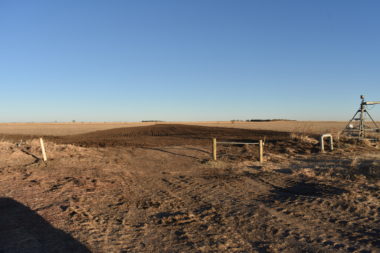Featured Project: Whitefront Wildlife Management Area
By Randy Stutheit, Wetland Biologist, NE Game and Parks Commission, Lincoln, NE
 The Whitefront Wildlife Management Area (WMA) is owned by the Nebraska Game and Parks Commission (NGPC) and is located 2 miles west and 2 miles north of Clay Center in Clay County. This WMA contains approximately 212 acres of wetland and 68 acres of upland habitat for a total of 280 acres. The Whitefront WMA was acquired over time as four separate tracts of land with the first tract being purchased in 1997. The WMA is open to public uses such as hunting, trapping, bird watching and hiking. It is managed primarily for waterfowl and upland game and is one of 36 WMAs owned and managed by the NGPC in the Rainwater Basin (RWB) region in southeast and south-central Nebraska. These 36 WMAs are scattered through 11 counties and contain a combined total of about 8,953 acres of wetland and upland wildlife habitat.
The Whitefront Wildlife Management Area (WMA) is owned by the Nebraska Game and Parks Commission (NGPC) and is located 2 miles west and 2 miles north of Clay Center in Clay County. This WMA contains approximately 212 acres of wetland and 68 acres of upland habitat for a total of 280 acres. The Whitefront WMA was acquired over time as four separate tracts of land with the first tract being purchased in 1997. The WMA is open to public uses such as hunting, trapping, bird watching and hiking. It is managed primarily for waterfowl and upland game and is one of 36 WMAs owned and managed by the NGPC in the Rainwater Basin (RWB) region in southeast and south-central Nebraska. These 36 WMAs are scattered through 11 counties and contain a combined total of about 8,953 acres of wetland and upland wildlife habitat.
The entire RWB wetland complex covers 6,100 square miles of land throughout 21 counties in Nebraska. Historically, this landscape contained over 11,000 shallow playa wetlands covering more than 204,000 acres, or approximately 5% of the landscape. Playas are primarily wind formed, isolated wetlands that are not connected to natural drainages. They are “perched” as much as 300 feet above the underlying aquifer and often function as groundwater recharge sites. Each wetland has a unique watershed that channels runoff from precipitation and snowmelt to the wetland. Water levels of RWB wetlands are very dynamic and fluctuate on both seasonal and yearly cycles. Levels can range from entirely dry to deeply flooded to everything in between. Before agricultural development, the uplands surrounding these wetlands were tall and mixed-grass prairie. Today, the RWB landscape is dominated by row-crop agriculture. Nearly 65% of the RWB landscape is cultivated for agricultural production while 19% remains in upland grasslands. RWB wetlands make up less than 1% of the landscape. Loss from various conversion activities has resulted in only 20% (40,000 acres) of the historic playa wetlands remaining in the RWB region.
 The watershed of the Whitefront WMA is approximately 965 acres. Runoff from rain and snowmelt supply water to the 212 acres of wetland habitat on the area. Additionally, two wells on the area can be used to provide supplemental water when needed. Most of the wetland is either seasonally or temporarily flooded at various times throughout the year. As is the case with most wetlands in the RWB region that are acquired by NGPC, there were various hydrology modification put in place by previous landowners in an attempt to shrink the size of the wetland and increase the amount of farmable land. These modifications consisted of 6 water concentration pits, water control berms and a large ring dike. In addition, trees and shrubs had colonized the berms and ring dike and invasive vegetation had invaded the wetland. Over time, increased sedimentation from the tilled ground surrounding the area decreased the depth of, and the water storage capacity of the wetland. Once NGPC acquires an area such as Whitefront WMA, these hydrology modifications are removed and attempts are made to restore the wetland to a more naturally functioning historic condition.
The watershed of the Whitefront WMA is approximately 965 acres. Runoff from rain and snowmelt supply water to the 212 acres of wetland habitat on the area. Additionally, two wells on the area can be used to provide supplemental water when needed. Most of the wetland is either seasonally or temporarily flooded at various times throughout the year. As is the case with most wetlands in the RWB region that are acquired by NGPC, there were various hydrology modification put in place by previous landowners in an attempt to shrink the size of the wetland and increase the amount of farmable land. These modifications consisted of 6 water concentration pits, water control berms and a large ring dike. In addition, trees and shrubs had colonized the berms and ring dike and invasive vegetation had invaded the wetland. Over time, increased sedimentation from the tilled ground surrounding the area decreased the depth of, and the water storage capacity of the wetland. Once NGPC acquires an area such as Whitefront WMA, these hydrology modifications are removed and attempts are made to restore the wetland to a more naturally functioning historic condition.
Over the past 17 years including 2020, NGPC has completed three wetland restoration/enhancement projects on the various tracts as they were added to the WMA. The first project completed in 2003 involved filling four of the water concentration pits with soil back to original grade, removal of a small dike, sediment removal, construction of a new low-level berm with a water control structure, the removal of trees growing around the pits and the placement of a water control structure on the County road culvert. Buried pipelines were installed to move water from the two wells directly into the wetland. The second project occurred in 2014. The ring dike west of the County road was removed and that material, along with sediment excavated from the wetland, was used to fill a large water concentration pit next to the road. Trees and shrubs growing on the ring dike were removed concurrent with the removal of the dike.
The third and most recently completed project was finished in December 2020. This final restoration project was completed on a 40 acre “roundout” tract to the WMA which had been acquired via a land trade. In conjunction with the Rainwater Basin Joint Venture and Ducks Unlimited, NGPC initiated a project to fill the last remaining water concentration pit in the wetland on the WMA, remove a second berm, remove sediment and trees and re-route the north buried pipeline to make water delivery more efficient. Runoff and groundwater pumped into the wetland will now be able to more effectively spread throughout the area providing an increase in high quality habitat for migratory water birds. A fence will be installed around the boundary of the new tract so grazing can occur for vegetative management.
Due to the fertility of the soil and the long growing season, Rainwater Basin wetlands require vegetation management on a yearly basis to maintain habitat in a healthy condition that is preferred by migratory waterfowl and shorebirds. NGPC land managers employ various techniques to control aggressive and invasive vegetation such as river bulrush, cattail, reed canary grass and trees, or to maintain the vegetative community in an existing preferred state. Depending on what vegetative species are present and what condition the habitat is in, the area manager will employ various management techniques to achieve their goals.
Since the first acquisition, land managers for the Whitefront WMA have been actively managing both the wetland and upland habitat. The wetland on the WMA is managed using prescribed fire, grazing, glyphosate spraying, and disking. On the uplands, prescribed fire, grazing and glyphosate spraying have been used to maintain early successional habitat favored by many upland species such as pheasants. Invasive trees including red cedar, Siberian elm, cottonwood and green ash have been removed from both the upland and wetland portions of the area. Whitefront WMA is managed equally for waterfowl and upland birds.
NGPC monitors and evaluates the Whitefront WMA every year to determine if more enhancement work is needed in the wetland. The area manager will continue to apply adaptive management annually to maintain the habitat in the best condition possible for both migratory and resident wildlife species.
















